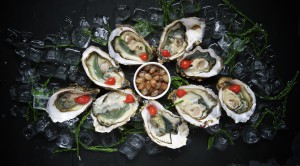The unique geographical situation of the Languedoc Roussillon region allows one to find a wide variety of products within a small area.
Indeed, located between sea and mountains, Languedoc Roussillon enjoys a perfect climate for agriculture of any kind and abounds with natural gastronomic wealth: seafood of all kinds, fruits, vegetables, grains and meats.
Therefore, the Languedoc cuisine is famous for its variety. On one side, the sea-oriented cuisine, mainly based on fish and shellfish, Bouzigues oysters, cod brandade, tielle of Sète, and on the other end, the inland country side that provides meats and cheeses.
Along the coast:
 The Mediterranean Sea is a delight for seafood lovers throughout the year. With its 275 km of coastline, the Languedoc Roussillon includes the top fishing port of the French Mediterranean: Sète. The Mediterranean region is famous mainly for the sea-bass, the Bluefin tuna, the red snapper sold directly to consumers, to restaurants and also to food products processors who prepare the famous brandade of Nimes, rouille of Sète and anchovies of Collioure.
The Mediterranean Sea is a delight for seafood lovers throughout the year. With its 275 km of coastline, the Languedoc Roussillon includes the top fishing port of the French Mediterranean: Sète. The Mediterranean region is famous mainly for the sea-bass, the Bluefin tuna, the red snapper sold directly to consumers, to restaurants and also to food products processors who prepare the famous brandade of Nimes, rouille of Sète and anchovies of Collioure.
And also numerous ponds and lagoons:
 Well ahead of arriving at the sandy beaches along the Mediterranean you will encounter many lagoons & ponds. Located between the plains and the shore, these bodies of water offer many seafood products including the Bouzigues oysters.
Well ahead of arriving at the sandy beaches along the Mediterranean you will encounter many lagoons & ponds. Located between the plains and the shore, these bodies of water offer many seafood products including the Bouzigues oysters.
Equipped with “Capéchades”, a traditional tool, fishermen go search for bream fish.
Some producers also work in those ponds, however at harvesting rice. From these particularly humid and fertile areas, thanks to the water evaporating from these ponds in the summer, one can harvest rice in Languedoc Roussillon.
The coastal plains and the dishes of Garrigue:
 Far past behind the populated urban coastal plains, the backcountry reveals itself little by little…
Far past behind the populated urban coastal plains, the backcountry reveals itself little by little…
Orchards & vineyards are one after the other. Thanks to its rich soil, vegetable and fruit farms are numerous but it is mostly the wine production that is dominating, and has been for years.
Growers, gardeners and vine growers coexist in these plains, stretching from the Northeast to the South of the region.
In the country of the “sun king”, ideal weather conditions allow growers to expand their orchards to the maximum. Peaches from Nîmes & Roussillon, cherries, apricots, melons and all, have therefore plenty of opportunities to grow every year in this beautiful region.
The mountains: livestock, cured meats
 To the west of the Languedoc Roussillon region, near the valley of the Aude River, the Black Mountain stretches almost from the city of Castres to the town of Camarès incorporating the mountain ranges of Lacaune and of l’Espinouse. Enjoying a cool dry climate, meat salting (process of preservation with salt) is still widely used, therefore craftsmen butchers are numerous.
To the west of the Languedoc Roussillon region, near the valley of the Aude River, the Black Mountain stretches almost from the city of Castres to the town of Camarès incorporating the mountain ranges of Lacaune and of l’Espinouse. Enjoying a cool dry climate, meat salting (process of preservation with salt) is still widely used, therefore craftsmen butchers are numerous.
Sheep and cattle breeding and raising, are intended to be not only traditional but also high quality, thanks to the hardy and rustic cattle breeds that are known as the “Fleur d’Aubrac”.
 The artisan cheese makers, on their side, perpetuate traditions and organize their lives around the rhythm of seasonal herd movements and the preparation of many “tome” and other local cheeses stamped with the AOC designation.
The artisan cheese makers, on their side, perpetuate traditions and organize their lives around the rhythm of seasonal herd movements and the preparation of many “tome” and other local cheeses stamped with the AOC designation.
In addition to being the birthplace of “Pélardon”, a famous goat cheese, the Cévennes region provides food connoisseurs with numerous fruits each year.
